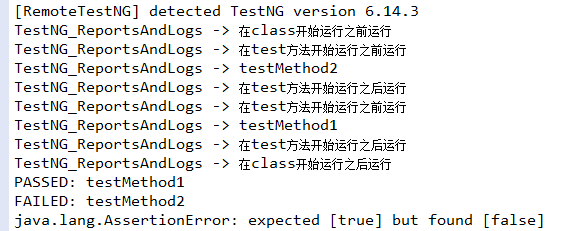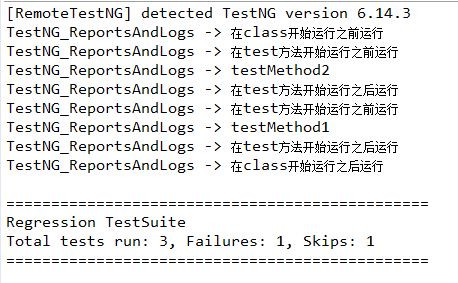一、在进行自动化的过程中,日志一般采用log4j 2进行日志记录,但TestNG自己本身也带有日志记录功能(reporter),它的好处在于日志中记录的内容都是testng自动生成的。
1 package testclasses1; 2 3 import org.testng.annotations.Test; 4 import org.testng.annotations.BeforeMethod; 5 import org.testng.annotations.AfterMethod; 6 import org.testng.annotations.BeforeClass; 7 import org.testng.Assert; 8 import org.testng.Reporter; 9 import org.testng.annotations.AfterClass; 10 11 public class TestNG_ReportsAndLogs { 12 13 @BeforeClass 14 public void setUp() { 15 // 需要传递2参数(String类型,Boolean)(需要打印的log信息,是否打印在控制台上true or false) 16 Reporter.log("TestNG_ReportsAndLogs -> 在class开始运行之前运行",true); 17 } 18 19 @AfterClass 20 public void cleanUp() { 21 Reporter.log("TestNG_ReportsAndLogs -> 在class开始运行之后运行",true); 22 } 23 24 @BeforeMethod 25 public void beforeMethod() { 26 Reporter.log("TestNG_ReportsAndLogs -> 在test方法开始运行之前运行",true); 27 } 28 29 @AfterMethod 30 public void afterMethod() { 31 Reporter.log("TestNG_ReportsAndLogs -> 在test方法开始运行之后运行",true); 32 } 33 34 @Test 35 public void testMethod1() { 36 Reporter.log("TestNG_ReportsAndLogs -> testMethod1",true); 37 } 38 39 @Test 40 public void testMethod2() { 41 Reporter.log("TestNG_ReportsAndLogs -> testMethod2",true); 42 Assert.assertTrue(false); 43 } 44 45 // 让testMethod3依赖testMethod2 46 @Test(dependsOnMethods= {"testMethod2"}) 47 public void testMethod3() { 48 Reporter.log("TestNG_ReportsAndLogs -> testMethod3",true); 49 } 50 }
运行截图:


二、如何查看reporter生成的HTML报告
1 package testclasses1; 2 3 import org.testng.annotations.Test; 4 import org.testng.annotations.BeforeMethod; 5 import org.testng.annotations.AfterMethod; 6 import org.testng.annotations.BeforeClass; 7 import org.testng.Assert; 8 import org.testng.Reporter; 9 import org.testng.annotations.AfterClass; 10 11 public class TestNG_ReportsAndLogs { 12 13 @BeforeClass 14 public void setUp() { 15 // 需要传递2参数(String类型,Boolean)(需要打印的log信息,是否打印在控制台上true or false) 16 Reporter.log("TestNG_ReportsAndLogs -> 在class开始运行之前运行",true); 17 } 18 19 @AfterClass 20 public void cleanUp() { 21 Reporter.log("TestNG_ReportsAndLogs -> 在class开始运行之后运行",true); 22 } 23 24 @BeforeMethod 25 public void beforeMethod() { 26 Reporter.log("TestNG_ReportsAndLogs -> 在test方法开始运行之前运行",true); 27 } 28 29 @AfterMethod 30 public void afterMethod() { 31 Reporter.log("TestNG_ReportsAndLogs -> 在test方法开始运行之后运行",true); 32 } 33 34 @Test 35 public void testMethod1() { 36 Reporter.log("TestNG_ReportsAndLogs -> testMethod1",true); 37 } 38 39 @Test 40 public void testMethod2() { 41 Reporter.log("TestNG_ReportsAndLogs -> testMethod2",true); 42 Assert.assertTrue(false); 43 } 44 45 // 让testMethod3依赖testMethod2 46 @Test(dependsOnMethods= {"testMethod2"}) 47 public void testMethod3() { 48 Reporter.log("TestNG_ReportsAndLogs -> testMethod3",true); 49 } 50 }
1、首先需要配置xml文件,然后运行
1 <!-- 没有此行配置运行时可能会报错 --> 2 <!DOCTYPE suite SYSTEM "http://testng.org/testng-1.0.dtd" > 3 <suite name="Regression TestSuite"> 4 <test name="Application Test"> 5 <classes> 6 <class name="testclasses1.TestNG_ReportsAndLogs"></class> 7 </classes> 8 </test> 9 </suite>
2、运行结果为:

3、xml配置文件运行后会出现如图所示的文件夹

4、HTML形式报告展示(截图有限,仅展示一部分)

如果有不明白的小伙伴可以私信问我,目前也建了qq、微信群,群里都是软件行业的小伙伴相互一起学习。
内容具有连惯性,未标注的地方可以看前面的博客,这是一整套关于ava+selenium自动化的内容,从java基础开始。
欢迎关注,转载请注明来源。



